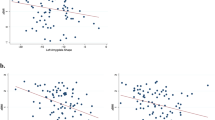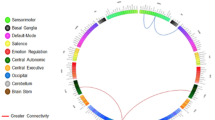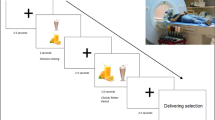Abstract
Background/objectives:
What drives overconsumption of food is poorly understood. Alterations in brain structure and function could contribute to increased food seeking. Recently, brain orbitofrontal cortex (OFC) volume has been implicated in dysregulated eating but little is known how brain structure relates to function.
Subjects/methods:
We examined obese (n=18, age=28.7±8.3 years) and healthy control women (n=24, age=27.4±6.3 years) using a multimodal brain imaging approach. We applied magnetic resonance and diffusion tensor imaging to study brain gray and white matter volume as well as white matter (WM) integrity, and tested whether orbitofrontal cortex volume predicts brain reward circuitry activation in a taste reinforcement-learning paradigm that has been associated with dopamine function.
Results:
Obese individuals displayed lower gray and associated white matter volumes (P<0.05 family-wise error (FWE)- small volume corrected) compared with controls in the orbitofrontal cortex, striatum and insula. White matter integrity was reduced in obese individuals in fiber tracts including the external capsule, corona radiata, sagittal stratum, and the uncinate, inferior fronto-occipital, and inferior longitudinal fasciculi. Gray matter volume of the gyrus rectus at the medial edge of the orbitofrontal cortex predicted functional taste reward-learning response in frontal cortex, insula, basal ganglia, amygdala, hypothalamus and anterior cingulate cortex in control but not obese individuals.
Conclusions:
This study indicates a strong association between medial orbitofrontal cortex volume and taste reinforcement-learning activation in the brain in control but not in obese women. Lower brain volumes in the orbitofrontal cortex and other brain regions associated with taste reward function as well as lower integrity of connecting pathways in obesity (OB) may support a more widespread disruption of reward pathways. The medial orbitofrontal cortex is an important structure in the termination of food intake and disturbances in this and related structures could contribute to overconsumption of food in obesity.
This is a preview of subscription content, access via your institution
Access options
Subscribe to this journal
Receive 12 print issues and online access
$259.00 per year
only $21.58 per issue
Buy this article
- Purchase on SpringerLink
- Instant access to full article PDF
Prices may be subject to local taxes which are calculated during checkout


Similar content being viewed by others
References
Odgen C, Carroll M . Prevalence of Overweight, Obesity, and Extreme Obesity Among Adults: United States, Trends 1976-1980 Through 2007-2008. Centers for Disease Control and Prevention: Hyattsville, MD, USA. 2010.
Morton GJ, Cummings DE, Baskin DG, Barsh GS, Schwartz MW . Central nervous system control of food intake and body weight. Nature 2006; 443: 289–295.
Berridge KC, Ho CY, Richard JM, DiFeliceantonio AG . The tempted brain eats: pleasure and desire circuits in obesity and eating disorders. Brain Res 2010; 1350: 43–64.
Volkow ND, Wang GJ, Tomasi D, Baler RD . Obesity and addiction: neurobiological overlaps. Obes Rev 2013; 14: 2–18.
Smith DG, Robbins TW . The neurobiological underpinnings of obesity and binge eating: a rationale for adopting the food addiction model. Biol Psychiatry 2013; 73: 804–810.
Carmichael ST, Price JL . Connectional networks within the orbital and medial prefrontal cortex of macaque monkeys. J Comp Neurol 1996; 371: 179–207.
Kelley AE, Berridge KC . The neuroscience of natural rewards: relevance to addictive drugs. J Neurosci 2002; 22: 3306–3311.
Avena NM, Rada P, Hoebel BG . Underweight rats have enhanced dopamine release and blunted acetylcholine response in the nucleus accumbens while bingeing on sucrose. Neuroscience 2008; 156: 865–871.
Johnson PM, Kenny PJ . Dopamine D2 receptors in addiction-like reward dysfunction and compulsive eating in obese rats. Nat Neurosci 2010; 13: 635–641.
Stice E, Yokum S, Blum K, Bohon C . Weight gain is associated with reduced striatal response to palatable food. J Neurosci 2010; 30: 13105–13109.
Frank GK, Reynolds JR, Shott ME, Jappe L, Yang TT, Tregellas JR et al. Anorexia nervosa and obesity are associated with opposite brain reward response. Neuropsychopharmacology 2012; 37: 2031–2046.
O'Doherty JP, Dayan P, Friston K, Critchley H, Dolan RJ . Temporal difference models and reward-related learning in the human brain. Neuron 2003; 38: 329–337.
Brooks SJ, Cedernaes J, Schioth HB . Increased prefrontal and parahippocampal activation with reduced dorsolateral prefrontal and insular cortex activation to food images in obesity: a meta-analysis of fMRI studies. PLoS One 2013; 8: e60393.
Hao X, Xu D, Bansal R, Dong Z, Liu J, Wang Z et al. Multimodal magnetic resonance imaging: The coordinated use of multiple, mutually informative probes to understand brain structure and function. Human Brain Mapping 2013; 34: 253–271.
Pannacciulli N, Del Parigi A, Chen K, Le DS, Reiman EM, Tataranni PA . Brain abnormalities in human obesity: a voxel-based morphometric study. Neuroimage 2006; 31: 1419–1425.
Brooks SJ, Benedict C, Burgos J, Kempton MJ, Kullberg J, Nordenskjold R et al. Late-life obesity is associated with smaller global and regional gray matter volumes: a voxel-based morphometric study. Int J Obes (Lond) 2013; 37: 230–236.
Frank GK, Shott ME, Hagman JO, Mittal VA . Alterations in brain structures related to taste reward circuitry in ill and recovered anorexia nervosa and in bulimia nervosa. Am J Psychiatry 2013; 170: 1152–1160.
Frank GK, Shott ME, Hagman JO, Yang TT . Localized brain volume and white matter integrity alterations in adolescent anorexia nervosa. J Am Acad Child Adolesc Psychiatry 2013; 52: 1066–1075 e1065.
Carnell S, Gibson C, Benson L, Ochner CN, Geliebter A . Neuroimaging and obesity: current knowledge and future directions. Obes Rev 2012; 13: 43–56.
Le Bihan D . Looking into the functional architecture of the brain with diffusion MRI. Nat Rev Neurosci 2003; 4: 469–480.
Stanek KM, Grieve SM, Brickman AM, Korgaonkar MS, Paul RH, Cohen RA et al. Obesity is associated with reduced white matter integrity in otherwise healthy adults. Obesity 2011; 19: 500–504.
Karlsson HK, Tuulari JJ, Hirvonen J, Lepomaki V, Parkkola R, Hiltunen J et al. Obesity is associated with white matter atrophy: A combined diffusion tensor imaging and voxel-based morphometric study. Obesity 2013; 21: 2530–2537.
Kringelbach ML . The human orbitofrontal cortex: linking reward to hedonic experience. Nat Rev Neurosci 2005; 6: 691–702.
Rolls ET . Functions of the orbitofrontal and pregenual cingulate cortex in taste, olfaction, appetite and emotion. Acta Physiol Hung 2008; 95: 131–164.
Garner D . Eating Disorder Inventory™-3 (EDI™-3). Psychological Assessment Resources, Inc.: Lutz, FL, 2004.
Cloninger C, Przybeck T, Svarkic D, Wetzel R . The Temperament and Character Inventory (TCI): A Guide to its Development and Use. Center for Psychobiology of Personality, Washington University: St. Louis, MO, USA, 1994.
Spielberger CD . Manual for the State-Trate Anxiety Inventory. Consulting Psychologists Press, Inc.: Palo Alto, CA, USA, 1983.
Beck AT, Ward CH, Mendelson M, Mock J, Erbaugh J . An inventory for measuring depression. Arch Gen Psychiatry 1961; 4: 561–571.
Torrubia R, Avila C, Molto J, Caseras X . The Sensitivity to Punishment and Sensitivity to Reward Questionnaire (SPSRQ) as a measure of Gray's anxiety and impulsivity dimensions. Personality and Individual Differences 2001; 31: 837–862.
Ashburner J . A fast diffeomorphic image registration algorithm. Neuroimage 2007; 38: 95–113.
Ashburner J, Friston KJ . Voxel-based morphometry—the methods. Neuroimage 2000; 11: 805–821.
Ashburner J, Friston KJ . Nonlinear spatial normalization using basis functions. Human Brain Mapping 1999; 7: 254–266.
Mori S, Crain BJ, Chacko VP, van Zijl PC . Three-dimensional tracking of axonal projections in the brain by magnetic resonance imaging. Ann Neurol 1999; 45: 265–269.
Zhang W, Olivi A, Hertig SJ, van Zijl P, Mori S . Automated fiber tracking of human brain white matter using diffusion tensor imaging. Neuroimage 2008; 42: 771–777.
Behrens TE, Berg HJ, Jbabdi S, Rushworth MF, Woolrich MW . Probabilistic diffusion tractography with multiple fibre orientations: what can we gain? Neuroimage 2007; 34: 144–155.
Mori S, Wakana S, van Zijl P, Nagae-Poetscher L . MRI Atlas of Human White Matter. Elsevier: Amsterdam, The Netherlands, 2005.
Benjamini Y, Hochberg Y . Controlling the false discovery rate: a practical and powerful approach to multiple testing. J R Statist Soc B 1995; 57: 289–300.
Jappe LM, Frank GK, Shott ME, Rollin MD, Pryor T, Hagman JO et al. Heightened sensitivity to reward and punishment in anorexia nervosa. Int J Eat Disord 2011; 44: 317–324.
Frank GK, Reynolds JR, Shott ME, O'Reilly RC . Altered temporal difference learning in bulimia nervosa. Biol Psychiatry 2011; 70: 728–735.
Pelchat ML, Johnson A, Chan R, Valdez J, Ragland JD . Images of desire: food-craving activation during fMRI. Neuroimage 2004; 23: 1486–1493.
Naqvi NH, Bechara A . The hidden island of addiction: the insula. Trends Neurosci 2009; 32: 56–67.
Tataranni PA, Gautier JF, Chen K, Uecker A, Bandy D, Salbe AD et al. Neuroanatomical correlates of hunger and satiation in humans using positron emission tomography. Proc Natl Acad Sci USA 1999; 96: 4569–4574.
O'Doherty JP, Deichmann R, Critchley HD, Dolan RJ . Neural responses during anticipation of a primary taste reward. Neuron 2002; 33: 815–826.
Pauli WM, Hazy TE, O'Reilly RC . Expectancy, ambiguity, and behavioral flexibility: separable and complementary roles of the orbital frontal cortex and amygdala in processing reward expectancies. J Cogn Neurosci 2012; 24: 351–366.
Wallis JD . Cross-species studies of orbitofrontal cortex and value-based decision-making. Nature Neuroscience 2012; 15: 13–19.
London ED, Ernst M, Grant S, Bonson K, Weinstein A . Orbitofrontal cortex and human drug abuse: functional imaging. Cereb Cortex 2000; 10: 334–342.
Kringelbach ML, O'Doherty J, Rolls E, Andrews C . Activation of the human orbitofrontal cortex to a liquid food stimulus is correlated with its subjective pleasantness. Cereb Cortex 2003; 13: 1064–1071.
Shefer G, Marcus Y, Stern N . Is obesity a brain disease? Neurosci Biobehav Rev 2013; 37: 2489–2503.
Ruch TC, Patton HD . The relation of the deep opercular cortex to taste. Fed Proc 1946; 5: 89.
Stice E, Spoor S, Bohon C, Veldhuizen MG, Small DM . Relation of reward from food intake and anticipated food intake to obesity: a functional magnetic resonance imaging study. J Abnorm Psychol 2008; 117: 924–935.
Cerf-Ducastel B, Van De Moortele PF, MacLeod P, Le Bihan D, Faurion A . Interaction of gustatory and lingual somatosensory perceptions at the cortical level in the human: a functional magnetic resonance imaging study. Chem Senses 2001; 26: 371–383.
Schmahmann JD, Smith EE, Eichler FS, Filley CM . Cerebral white matter: neuroanatomy, clinical neurology, and neurobehavioral correlates. Ann N Y Acad Sci 2008; 1142: 266–309.
Onoda K, Ikeda M, Sekine H, Ogawa H . Clinical study of central taste disorders and discussion of the central gustatory pathway. J Neurol 2012; 259: 261–266.
Mettler LN, Shott ME, Pryor T, Yang TT, Frank GK . White matter integrity is reduced in bulimia nervosa. Int J Eat Disord 2013; 46: 264–273.
Kazlouski D, Rollin MD, Tregellas J, Shott ME, Jappe LM, Hagman JO et al. Altered fimbria-fornix white matter integrity in anorexia nervosa predicts harm avoidance. Psychiatry Res 2011; 192: 109–116.
Acknowledgements
We contributed significantly to this manuscript. We would like to thank all the individuals who participated in this study. This work was supported by NIMH grant K23 MH080135-01A2, NIMH grant R01 MH096777, and by the Davis Foundation Award of the Klarman Family Foundation Grants Program in Eating Disorders (all GKWF).
Author information
Authors and Affiliations
Corresponding author
Ethics declarations
Competing interests
The authors declare no conflict of interest.
Rights and permissions
About this article
Cite this article
Shott, M., Cornier, MA., Mittal, V. et al. Orbitofrontal cortex volume and brain reward response in obesity. Int J Obes 39, 214–221 (2015). https://doi.org/10.1038/ijo.2014.121
Received:
Revised:
Accepted:
Published:
Issue Date:
DOI: https://doi.org/10.1038/ijo.2014.121
This article is cited by
-
Diffusion tensor imaging findings in the hunger and satiety centers of the brain after bariatric surgery: a preliminary study
Irish Journal of Medical Science (1971 -) (2024)
-
The genetics of a “femaleness/maleness” score in cardiometabolic traits in the UK biobank
Scientific Reports (2023)
-
Association between parental age, brain structure, and behavioral and cognitive problems in children
Molecular Psychiatry (2022)
-
Long-term changes in insula-mesolimbic structural and functional connectivity in obese patients after laparoscopic sleeve gastrectomy
Clinical Autonomic Research (2022)
-
Accurate neuroimaging biomarkers to predict body mass index in adolescents: a longitudinal study
Brain Imaging and Behavior (2020)



